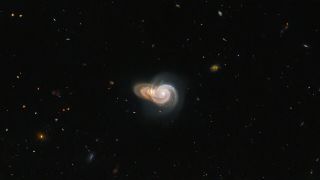Hubble Space Telescope captures two 'overlapping' spiral galaxies in new photo

A new photo from NASA's iconic space telescope captures two distant "overlapping" spiral galaxies.
The galaxies, called SDSS J115331 and LEDA 2073461, are located more than a billion light-years from Earth. While the new Hubble Space Telescope view suggests the two galactic bodies are merging, it's just an optical illusion and the galaxies aren't actually interacting with each other at all, according to a statement from the European Space Agency (ESA), which is a partner on the observatory.
"Despite appearing to collide in this image, the alignment of the two galaxies is likely just by chance — the two are not actually interacting," ESA officials wrote in the statement. "While these two galaxies might simply be ships that pass in the night, Hubble has captured a dazzling array of interacting galaxies in the past."
Related: The best Hubble Space Telescope images of all time!
The chance alignment of the two galaxies, as seen by Hubble, offers a stunning head-on view of the closer galaxy with its spiral arms stretched out on either side.
The recent photo, which ESA shared on Sept. 5, was created using observations from the space agency's Galaxy Zoo project. This citizen science-based initiative began in 2007 to crowdsource galaxy classifications to hundreds of thousands of participants.
1/ This Hubble Picture of the Week shows two overlapping spiral galaxies 🌀: SDSS J115331 and LEDA 2073461. Their appearance gives the impression of a dramatic collision. But don’t be fooled! These two galaxies are not actually interacting – their alignment is just by chance. pic.twitter.com/zQyYOIkSU5September 5, 2022
"These volunteers classify galaxies imaged by robotic telescopes and are often the first to ever set eyes on an astronomical object," ESA officials wrote in the statement.
Get the Space.com Newsletter
Breaking space news, the latest updates on rocket launches, skywatching events and more!
In fact, volunteers of the Galaxy Zoo project have helped discover all sorts of interesting cosmic objects, ranging from unusual three-armed spiral galaxies to colliding ring galaxies. The targets chosen for further study by Hubble are selected by a public vote, according to the statement.
Follow Samantha Mathewson @Sam_Ashley13. Follow us on Twitter @Spacedotcom and on Facebook.
Join our Space Forums to keep talking space on the latest missions, night sky and more! And if you have a news tip, correction or comment, let us know at: community@space.com.

Samantha Mathewson joined Space.com as an intern in the summer of 2016. She received a B.A. in Journalism and Environmental Science at the University of New Haven, in Connecticut. Previously, her work has been published in Nature World News. When not writing or reading about science, Samantha enjoys traveling to new places and taking photos! You can follow her on Twitter @Sam_Ashley13.
